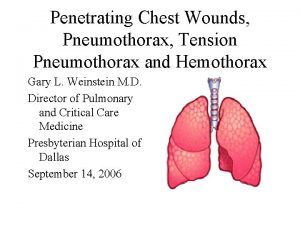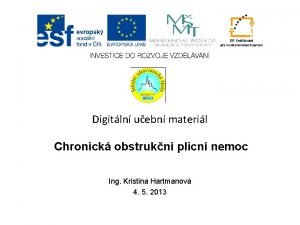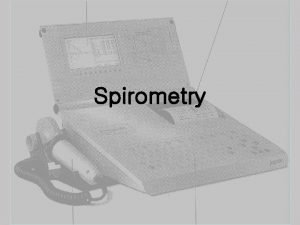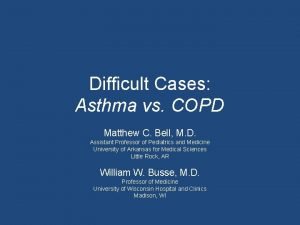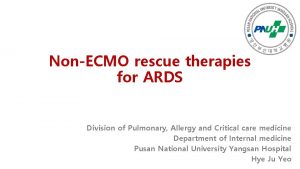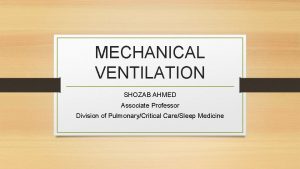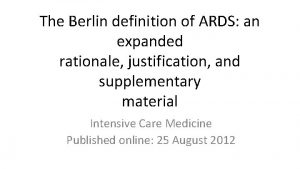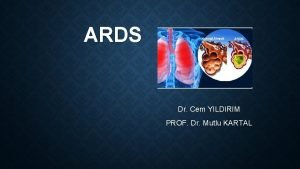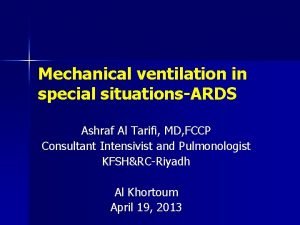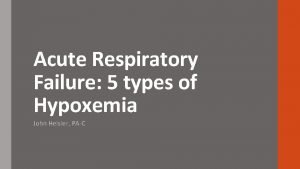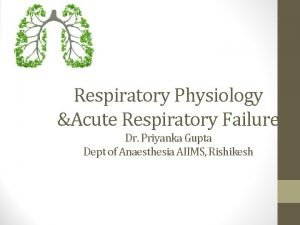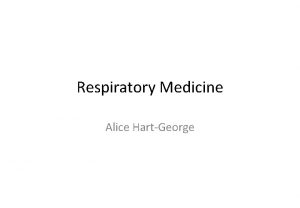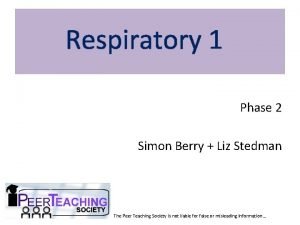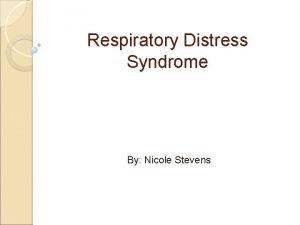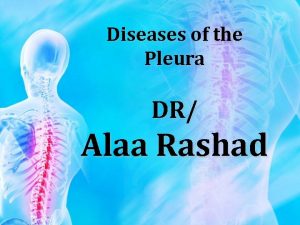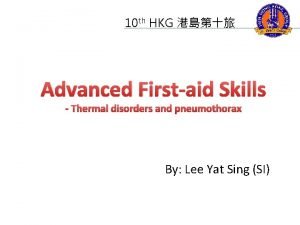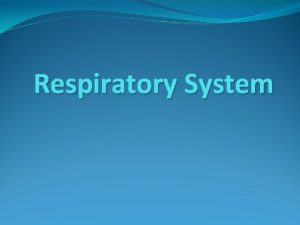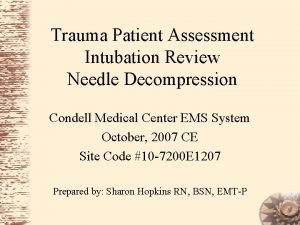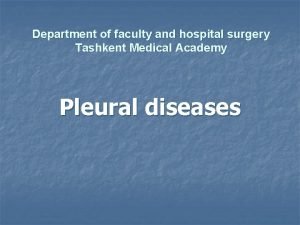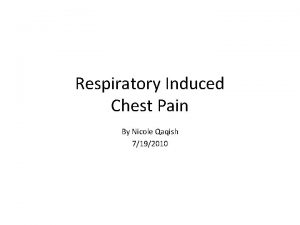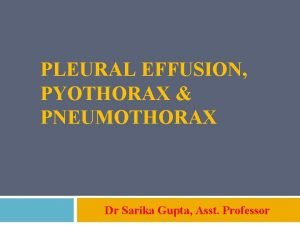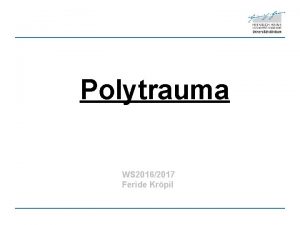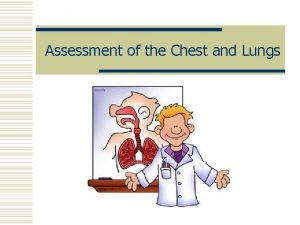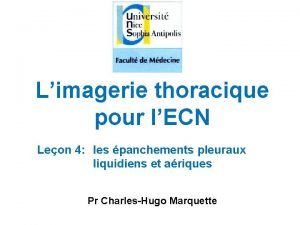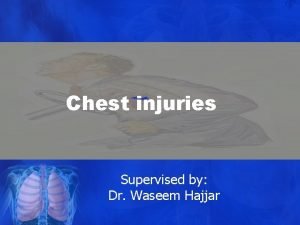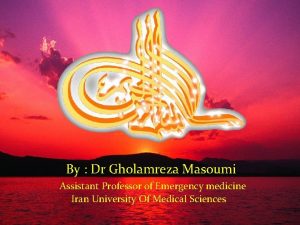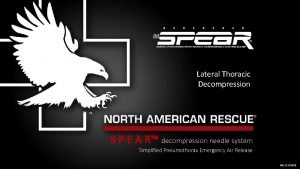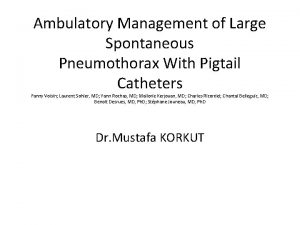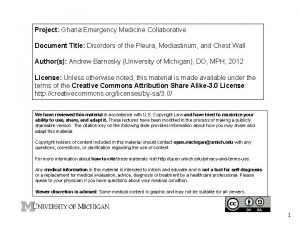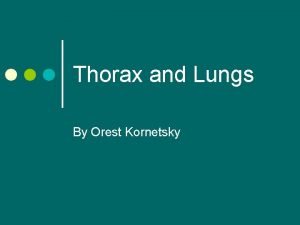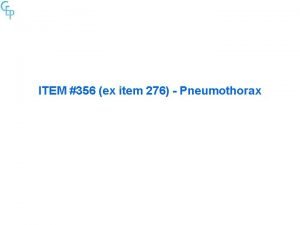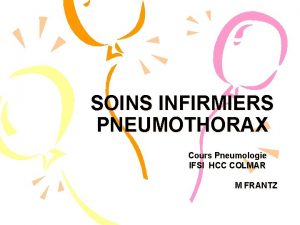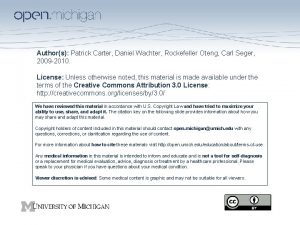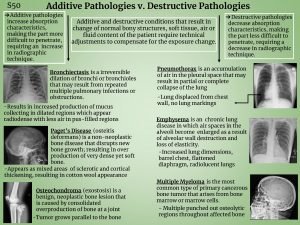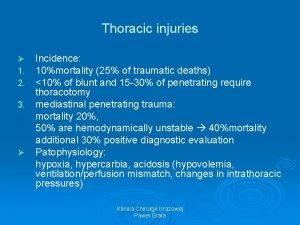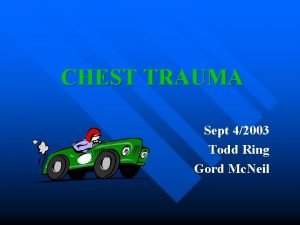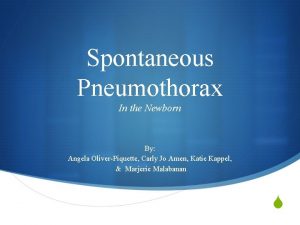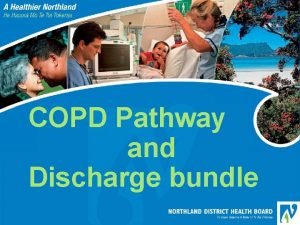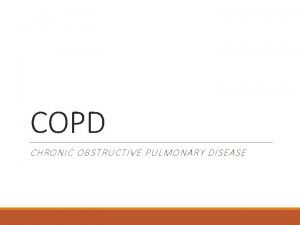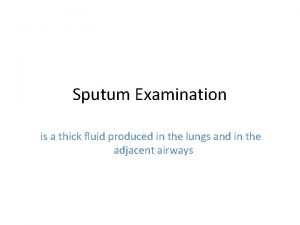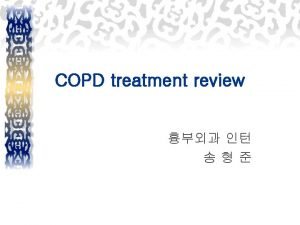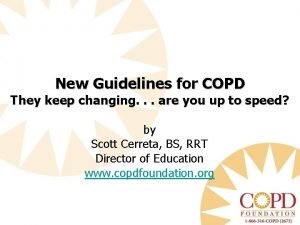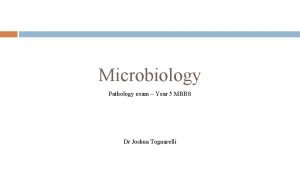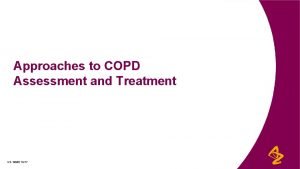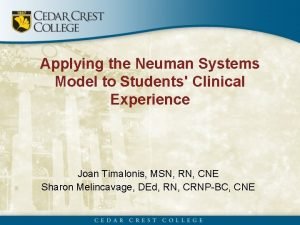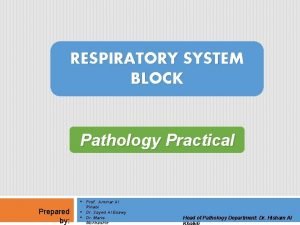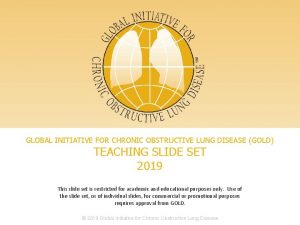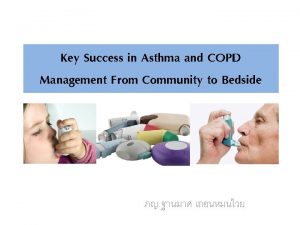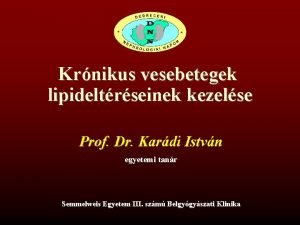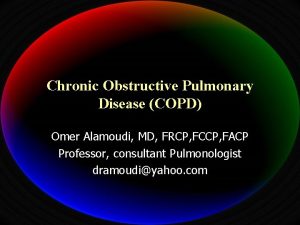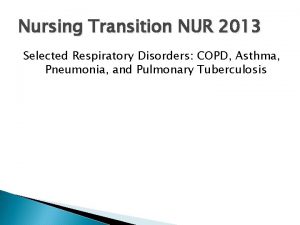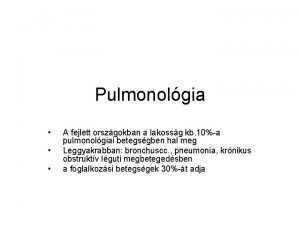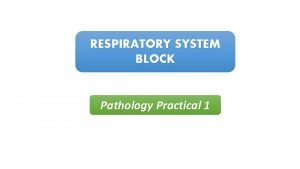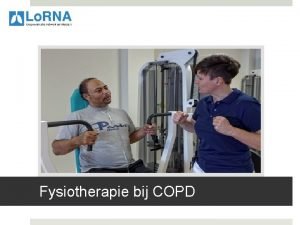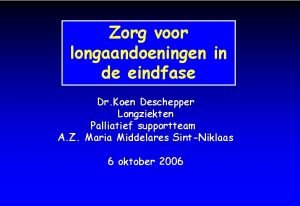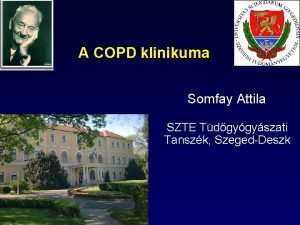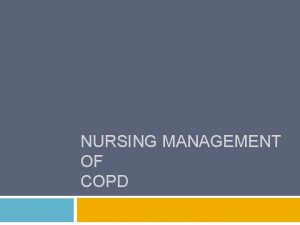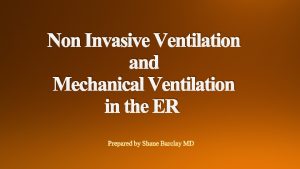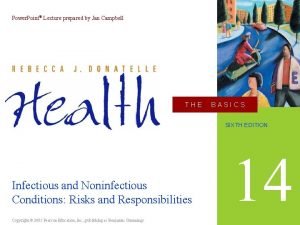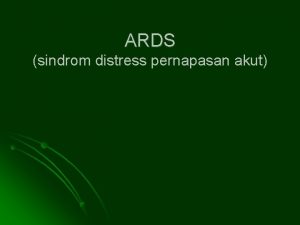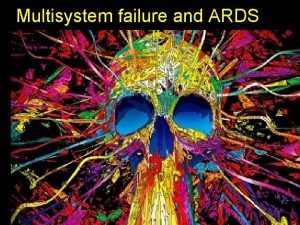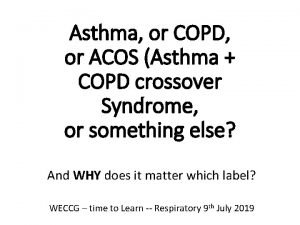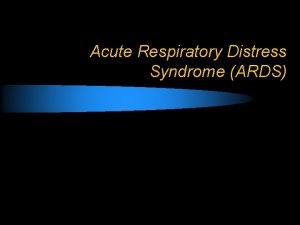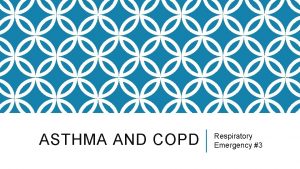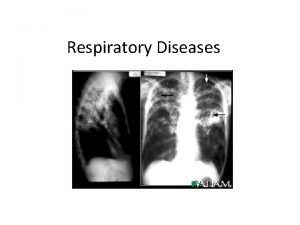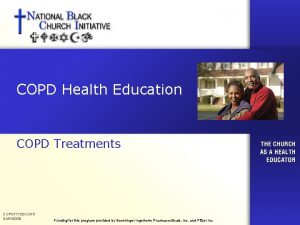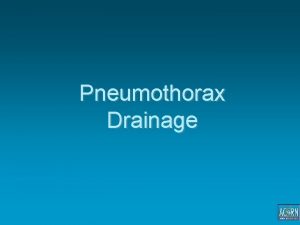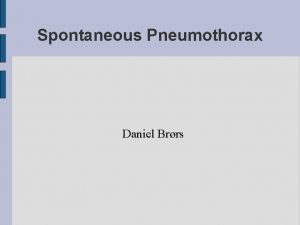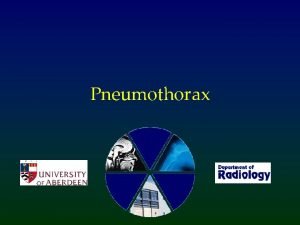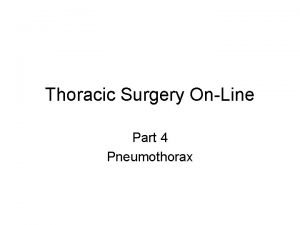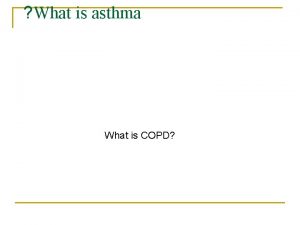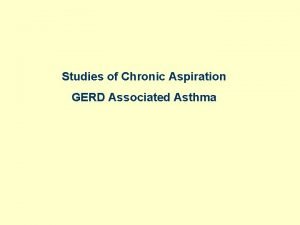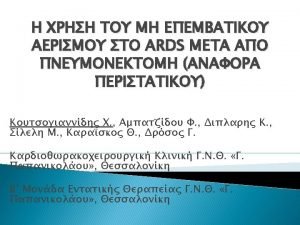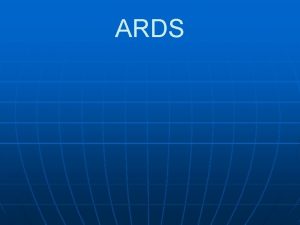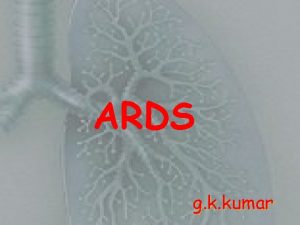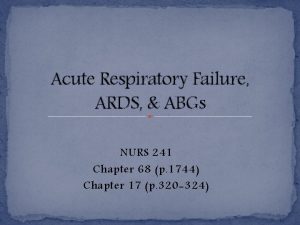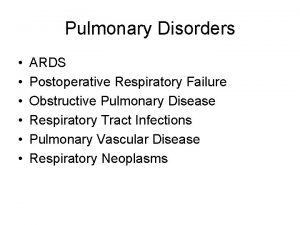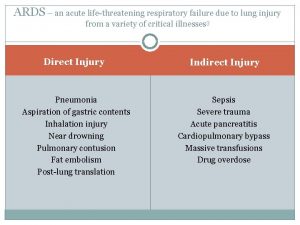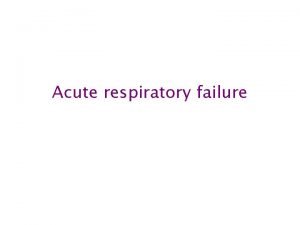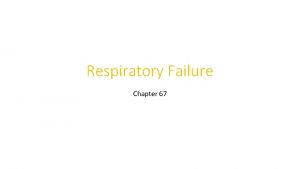Respiratory failure ARDS Asthma CHOPN COPD Aspiration Pneumothorax


















































































- Slides: 82

Respiratory failure ARDS Asthma CHOPN (COPD) Aspiration Pneumothorax

ARF is not a specific disease but a reaction to an underlying condition, e. g. trauma, sepsis or pneumonia. Due to different definitions, the incidence and mortality rates for ARF vary across studies. In addition, the underlying condition strongly influences prognosis. 2

Respiratory failure Acute respiratory failure (ARF) is a common and important indication for critical care with a substantial mortality. It is defined as all acute lung conditions with the exception of chornic obstructive lung disease that require active therapy.

Pump failure or lung failure ? The respiratory system can be modelled as a gas exchanger (the lungs) ventilated by a pump. The dysfunction of each of the two parts, pump or lungs, may cause respiratory failure defined as inability to maintain adequate blood gases while breathing ambient air. 4

Pump failure primarily results in alveolar hypoventilation, hypercapnia and respiratory acidosis. 5

Pump failure Insufficient alveolar ventilation may result from a number of causes intrinsically affecting one or more of the elements of the complex chain that starts from: the respiratory centres (pump controller) central and peripheral nervous ways chest wall, the latter including both the respiratory muscles and all the passive parts that couple the muscles with the lungs. 6

Pump failure Insufficient alveolar ventilation may even take place in the absence of any intrinsic problem of the pump, when a high ventilation load overcomes the natural capacity of the pump. Excessive load can be caused by airway obstruction, respiratory system stiffening or high ventilation requirement, and finally results in intrinsic pump dysfunction due to respiratory muscle fatigue. 7

Lung failure results from any damage of the natural gas exchanger: alveoli, airways and vessels. Lung failure involves impaired oxygenation and impaired CO 2 elimination depending on a variable combination of: True intrapulmonary shunt Increased alveolar dead space Lung damage also involves increased ventilation requirement and mechanical dysfunctions resulting in high impedance to ventilation. 8

Cause intoxikation, cerbral insult sy Guillain Barré, trauma, poliomyelitis myastenia, neuritis, tetanus, botulism PNO, haemothorax upper airway obstruction asthma, COPD, bronchiolitis, fibrosis, ARDS, aspiration cardiology 9

ARDS - Acute Respiratory Distress Syndrome 10

ARDS is defined as an inflammatory process in the lungs with: An acute onset of respiratory failure meaning onset over 1 week or less New onset bilateral opacites on frontal chest radiograph Absence of left ventricular failure (clinically diagnosed ) Hypoxaemia express with a ratio between the partial pressure of oxygen in the arterial blood and the fraction of inspired oxygen (Pa. O 2/Fi. O 2) 1 1

ARDS is categorized as mild, moderate, or severe: mild (Pa. O 2/FIO 2 ≤ 300 mm Hg) moderate (Pa. O 2/FIO 2 ≤ 200 mm Hg) severe (Pa. O 2/FIO 2 ≤ 100 mm Hg) 12

Aetiology and risk factor ARDS is an acute inflammatory condition in the lungs and not a disease in itself, and is therefore always due to an underlying disease process. The pulmonary inflammation is caused by: A direct (primary or pulmonary) injury to the lungs (pneumonia) An indirect (secondary or extra-pulmonary) injury (sepsis, pancreatitis, trauma, major surgery, …) 13

Pulmonary manifestations and symptoms Cyanosis due to hypoxaemia Tachypnoea Dyspnoea due to a higher work of breathing in order to compensate for an impaired gas exchange High-pitched crackles heard in all lung fields 1 4

Extra-pulmonary manifestations and symptoms The underlying process might dominate the clinical picture in the early phase of ARDS. In trauma, local signs, pain and circulatory shock are prominent in sepsis, fever and laboratory and clinical signs of impaired perfusion are important manifestations. 15

16

ARDS - CT

Lung protective ventilatory strategy The goal for ventilatory therapy in ARF is to provide an adequate gas exchange (usually Pa. O 2 >8 k. Pa, oxygen saturation of haemoglobin in arterial blood (Sa. O 2) >90% and p. H 7. 2 -7. 4) There are no ventilatory modes that have been conclusively proven to be superior in ARF when limiting end-inspiratory plateau pressures and tidal volumes Ventilation with Vt 6 ml/kg ideal body weight The end-inspiratory plateau airway pressures should be kept low (<30 -35 cm H 2 O). Low tidal volume and low pressure ventilation might reduce CO 2 elimination and this ventilatory approach has therefore been termed ‘permissive hypercapnia’. 18

Positive end-expiratory pressure May prevent collapse of open and perfused lung regions and thus maintain arterial oxygenation Therefore, PEEP should ideally be set at a high level (about 10 -15 cm H 2 O) immediately after a lung recruitment manoeuvre 19

‘Open up the lung and keep it open’ Strategy lung recruitment manoeuvre to open up collapsed lung regions followed by an adequate PEEP to prevent the recruited lung regions from recollapsing. This approach is usually effective in improving arterial oxygenation in early ARDS. 20

Other Therapy Otherapies proposed to increase oxygenation and resolution of ARDS as well as infectious control Nutritional support fluid management prone position 21

COPD and Asthma Chronic obstructive pulmonary disease (COPD) is a worldwide and rapidly growing health problem: it was the sixth leading cause of death worldwide in 1990 and is expected to become third leading cause by 2020. Transient worsening of the chronically altered lung function (so-called exacerbation of COPD) may lead to life-threatening respiratory insufficiency requiring ventilatory support. Mortality from asthma is also not negligible: it is estimated at 1 -8 per 100 000 annually. 22

Asthma Although inflammation is important in both COPD and asthma, the inflammatory response is quite different in the two diseases. Inflammation has greater clinical significance in asthma and therefore is more responsive to corticosteroids. The importance of bronchospasm and the related bronchial sensitivity are much greater in asthma as well. In contrast to COPD, most of the bronchial obstruction in asthma is reversible. 23

Clinical findings (asthma): Immediately life-threatening clinical features are: Silent chest, weak respiratory efforts and cyanosis Confusion or coma Bradycardia and hypotension Peak expiratory flow rate (PEFR) unmeasurable Clinical signs of severe asthma are: Inability to complete sentences in one breath Respiratory rate (RR) >30/min Tachycardia >120/min PEFR <50% of predicted normal or of best normal if known (<200 l/min if not known) Arterial paradox (the fall in systolic pressure on 24 inspiration) >20 mm. Hg

G lobal Initiative for Chronic O bstructive L ung D isease 25

GOLD main method to describe the severity of chronic obstructive pulmonary disease (COPD). the GOLD staging system classifies people with COPD based on their degree of airflow limitation (obstruction). The airflow limitation is measured during pulmonary function tests (PFTs). 26

Mechanisms Underlying Airflow Limitation in COPD Small Airways Disease Parenchymal Destruction • Airway inflammation • Airway fibrosis, luminal plugs • Increased airway resistance • Loss of alveolar attachments • Decrease of elastic recoil AIRFLOW LIMITATION 27

Risk Factors for COPD Genes • Lung growth and development Tobacco smoke • Gender Exposure to particles • Age Occupational dusts, organic • Respiratory infections and inorganic • Socioeconomic status Indoor air pollution from • Asthma/Bronchial heating and cooking with hyperreactivity biomass in poorly ventilated • Chronic Bronchitis dwellings Outdoor air pollution 28

Diagnosis of COPD SYMPTOMS shortness of breath chronic cough sputum EXPOSURE TO RISK FACTORS tobacco occupation indoor/outdoor pollution SPIROMETRY: Required to establish diagnosis 29

Assessment of Airflow Limitation: Spirometry When blowing out forcefully, people with normal lungs can exhale most of the air in their lungs in one second. Pulmonary function tests measure this and other values, and are used to diagnose COPD and its severity: The volume in a one-second forced exhalation is called the forced expiratory volume in one second (FEV 1), measured in liters, In people with normal lung function, FEV 1 is at least 70% of FVC. The total exhaled breath is called the forced vital capacity (FVC), also measured in liters. 30

Diagnosis and Assessment: A clinical diagnosis of COPD should be considered in any patient who has dyspnea, chronic cough or sputum production, and a history of exposure to risk factors for the disease. Spirometry is required to make the diagnosis; the presence of a post-bronchodilator FEV 1/FVC < 0. 70 confirms the presence of persistent airflow limitation and thus of COPD. 31

Classification of Severity of Airflow Limitation in COPD In patients with FEV 1/FVC < 0. 70: GOLD 1: Mild FEV 1 > 80% predicted GOLD 2: Moderate 50% < FEV 1 < 80% predicted GOLD 3: Severe 30% < FEV 1 < 50% predicted GOLD 4: Very Severe FEV 1 < 30% predicted Based on Post-Bronchodilator FEV 1 32

Comorbidities COPD patients are at increased risk for: Cardiovascular diseases Osteoporosis Respiratory infections Anxiety and Depression Diabetes Lung cancer These comorbid conditions may influence mortality and hospitalizations and should be looked for routinely, and treated appropriately. 33

Differential Diagnosis: COPD and Asthma COPD ASTHMA Onset in mid-life Onset early in life (often childhood) Symptoms slowly Symptoms vary from day to day progressive Long smoking history Symptoms worse at night/early morning Allergy, rhinitis, and/or eczema also present Family history of asthma 34

Additional Investigations Chest X-ray: Seldom diagnostic but valuable to exclude alternative diagnoses and establish presence of significant comorbidities. Oximetry and Arterial Blood Gases: Pulse oximetry can be used to evaluate a patient’s oxygen saturation and need for supplemental oxygen therapy. 35

Beta 2 -agonists Short-acting beta 2 -agonists Long-acting beta 2 -agonists Anticholinergics Short-acting anticholinergics Long-acting anticholinergics Combination short-acting beta 2 -agonists + anticholinergic in one inhaler Methylxanthines

Therapeutic Options: Combination Therapy An inhaled corticosteroid combined with a long-acting beta 2 -agonist is more effective than the individual components in improving lung function and health status and reducing exacerbations in moderate to very severe COPD. Combination therapy is associated with an increased risk of pneumonia. Addition of a long-acting beta 2 -agonist/inhaled glucorticosteroid combination to an anticholinergic appears to provide additional benefits. 37

Therapeutic Options: Systemic Corticosteroids Chronic treatment with systemic corticosteroids should be avoided because of an unfavorable benefit-to-risk ratio. 38

Therapeutic Options: Theophylline is less effective and less well tolerated than inhaled long-acting bronchodilators and is not recommended if those drugs are available and affordable. There is evidence for a modest bronchodilator effect and some symptomatic benefit compared with placebo in stable COPD. Addition of theophylline to salmeterol produces a greater increase in FEV 1 and breathlessness than salmeterol alone. Low dose theophylline reduces exacerbations but does not improve post-bronchodilator lung function. 39

Therapeutic Options: Other Pharmacologic Treatments Influenza vaccines can reduce serious illness. Pneumococcal polysaccharide vaccine is recommended for COPD patients 65 years and older and for COPD patients younger than age 65 with an FEV 1 < 40% predicted. The use of antibiotics, for treating infectious exacerbations of COPD and other bacterial infections. 40

Therapeutic Options: Other Pharmacologic Treatments Mucolytic: Patients with viscous sputum may benefit from mucolytics; overall benefits are very small. Antitussives: Not recommended. 41

Therapeutic Options: Other Treatments Oxygen Therapy: The long-term administration of oxygen (> 15 hours per day) to patients with chronic respiratory failure has been shown to increase survival in patients with severe, resting hypoxemia. Ventilatory Support: Combination of noninvasive ventilation (NIV) with long-term oxygen therapy may be of some use in a selected subset of patients, particularly in those with pronounced daytime hypercapnia. 42

Therapeutic Options: Other Treatments Palliative Care, End-of-life Care, Hospice Care: Communication with advanced COPD patients about end-of-life care and advance care planning gives patients and their families the opportunity to make informed decisions. 43

Exacerbation of COPD is an event in the natural course of the disease characterised by a change in the patient’s baseline dyspnoea, cough and/or sputum beyond day-to-day variability, sufficient to warrant a change in management 44

Manage Exacerbations: The most common causes of COPD exacerbations are viral upper respiratory tract infections and infection of the tracheobronchial tree. The goal of treatment is to minimize the impact of the current exacerbation and to prevent the development of subsequent exacerbations. 45

Manage Exacerbations: Short-acting inhaled beta 2 -agonists with or without short-acting anticholinergics are usually the preferred bronchodilators for treatment of an exacerbation. Systemic corticosteroids and antibiotics can shorten recovery time, improve lung function (FEV 1) and arterial hypoxemia (Pa. O 2), and reduce the risk of early relapse, treatment failure, and length of hospital stay. COPD exacerbations can often be prevented. 46

Manage Exacerbations: Treatment Options Antibiotics should be given to patients with three cardinal symptoms : 1. increased dyspnea 2. increased sputum volume 3. increased sputum purulence. Who require mechanical ventilation. 47

Manage Exacerbations: Treatment Options Noninvasive ventilation (NIV) for patients hospitalized for acute exacerbations of COPD: Improves respiratory acidosis, decreases respiratory rate, severity of dyspnea, complications and length of hospital stay. Decreases mortality and needs for intubation. 48

Oxygen If the patient is hypoxaemic, oxygen must be applied in acute asthma and also in COPD exacerbation. It is, however, important to know that in COPD, p. CO 2 might rise, requiring iterative blood gases to avoid CO 2 narcosis, and titration of Fi. O 2 so that Sa. O 2 reaches but does not exceed 90%. If reaching this target induces a significant worsening of the respiratory acidosis, there is a clear indication for ventilatory support! 49

Ventilatory support The indications for ventilatory support (two out of three should be present) include: At least moderate dyspnoea, with use of accessory muscles and paradoxical abdominal motion Hypercapnic acidosis (p. H <7. 35) 50

Ventilation The most commonly used ventilatory mode is pressure support with PEEP, or BIPAP in case of insufficient respiratory drive. There are no clearly defined criteria for the initiation of invasive mechanical ventilation in COPD or asthma. In COPD, the current approach is to intubate the patient if non-invasive ventilation fails, i. e. if blood gases and clinical status do not improve within one hour of initiation of non-invasive mechanical ventilation. In asthma, the primary goal of intubation and mechanical ventilation is to maintain oxygenation and prevent respiratory arrest. Once a decision to intubate has been made, the goal is to gain rapid and complete control of the patient’s cardiorespiratory status. 51

Ventilation If it is not possible to reach normoventilation within the safe parameters as mentioned above, it is recommended to use so-called permissive hypercapnia to avoid mechanical lung damage. Hypercapnic acidosis is usually well tolerated 52

Trauma 53

54

55

56

57

58

Mechanical ventilation Today, major technological advancements allow use of mechanical ventilators as sophisticated assistants of the respiratory pump. Positive pressure ventilation can also be very effective in lung failure. The safe management of mechanical ventilation requires precise information about the individual disorders of respiratory mechanics 59

Mechanical ventilation The mechanical ventilator is an artificial organ, external to the body, which was conceived originally to replace, and later to assist, the inspiratory muscles. Its primary action is promotion of alveolar ventilation and CO 2 elimination, but it is normally used also for the difficult task of correcting impaired oxygenation. 60

The function of the ventilator is to help get oxygen into the patient and carbon dioxide out CO 2 61

Invasive vs non-invasive techniques In intensive care, positive pressure ventilators are used most commonly, i. e. machines that promote alveolar ventilation by applying positive pressures at the airway opening of the patient. In intensive care, two kinds of interface are used: Endotracheal tube (or tracheostomy): The classic, invasive approach Mask: The non-invasive approach 62

Intubation The invasive approach has a number of disadvantages associated with endotracheal intubation, such as: Deprese of cough effectiveness Increase of airway resistance Risk of different types of damage of the bypassed airway Loss of the ability to speak Loss of the protective functions of the upper airway (gas heating, gas humidification, and protection from infections) 63

NIV Safe and effective management of mask ventilation has precise requirements: At least some residual ability of spontaneous breathing (the need for full mechanical support is an absolute contraindication for a non-invasive approach) No estimated need of high levels of positive pressure Haemodynamic stability Good cooperation from the patient The ability of the patient to protect his own airway No acute facial trauma, skull base fracture, or recent digestive surgery 6 4

65

Spontaneous breathing 66

CPAP (Continuous Positive Airwav Pressure) Spontaneous breathing with CPAP. All breaths are fully spontaneous, and the inspiratory pressure is ideally equal to the set PEEP level. Technically, when applied with a mechanical ventilator, spontaneous breathing with CPAP is identical to PSV with a pressure support of zero. 67

PS (Pressure Support) Pressure Support Ventilation (PSV). This is based on spontaneous breaths assisted by a pre-set pressure. 68

SIMV (Synchronized Intermittent Mandatory Ventilation) This mode alternates assist-control volumetric inflations (delivered according to a user-set mandatory frequency) and breaths that can be either assisted-spontaneous (when pressure support is set above zero) 69

ACV (Assist Control) 70

PCV/VCV(Pressure/Volum Controlled Ventilation) Volume-Controlled Ventilation (VCV). In this mode the tidal volume (Vt) is preset. Breaths are either controlled or assist-controlled, depending on the lack or presence of patient’s inspiratory activity Pressure-Controlled Ventilation (PCV). In this mode inspiration is promoted by a pre-set pressure. Breaths are either controlled or assist-controlled, depending on the lack or presence of patient’s inspiratory activity 71

PCV/VCV(Pressure/Volum Controlled Ventilation) 72

Cycling to exhalation: Machine vs patient When controlled by the machine, cycling is normally time-based. Time cycling means that the ventilator switches to exhalation as soon as the set inspiratory time (Ti) is elapsed. Patient-controlled cycling is used in assistedspontaneous and fully spontaneous breaths. The expiratory trigger is based on the measurement of the inspiratory flow. When the inspiratory flow falls below a threshold value, the ventilator considers that the inspiratory effort should be close to the end, and 73 hence cycles to exhalation.

Inspiratory time The normal I: E ratio is between 1: 2 and 1: 1. 5, corresponding to an inspiratory duty cycle of 3340%. 74

Trigger pressure-trigger: the ventilator watches the airway pressure during exhalation. When the patient contracts his inspiratory muscles, the airway opening pressure drops below the baseline. When this drop reaches a pressure threshold defined by the trigger sensitivity control, the machine responds by starting the inspiratory phase of the respiratory cycle. flow-trigger: the ventilator watches the airflow. When the patient contracts his inspiratory muscles, the airflow reverses from expiratory or zero to inspiratory values. When the inspiratory flow generated by the patient reaches the trigger sensitivity threshold, the machine responds. 75

PEEP contributes to the reopening of collapsed alveoli and opposes alveolar collapse. PEEP artificially increases the functional residual capacity and, by increasing the number of alveoli that are open to ventilation, it improves the lung compliance. PEEP level of up to 5 cm. H 2 O has minor adverse effects and contraindications, and can be used in most patients. In most ALI-ARDS cases, a PEEP of 10 -15 cm. H 2 O is necessary Improves oxygenation 76

Respiratory complications Nosocomial pneumonia Barotrauma: High pressures (barotrauma) High volumes (volutrauma) Shear injury Gas trapping 77

Cardiovascular effects Preload positive intrathoracic pressure reduces venous return exacerbated by high inspiratory pressure prolonged inspiratory time PEEP 78

Ventilators are comprised of four main groups of elements: An internal source of pressurised gas including a blender for air and oxygen The inspiratory valve, the expiratory valve and the ventilator circuit A control system, including control panel, monitoring and alarms A system for ventilator-patient synchronisation 79

Parts of the external circuit the inspiratory line, expiratory line Y-piece flexible tube for patient connection the external circuit can be very different, depending on the location of the expiratory valve, and on the system used for gas conditioning 80

Gas conditioning The inspiratory gas delivered to the patient must be adequately heated and humidified. Gas conditioning can be obtained by means of: Heat and Moisture Exchanger (HME) mounted at the Y-piece Heated humidifier mounted within the inspiratory line. 81

De-escalation and weaning De-escalation is a process that should be started as soon as a generic, even minimum improvement in patient’s respiratory state is found. De-escalation involves Fi. O 2, PEEP, and mechanical support to alveolar ventilation and respiratory muscles. Weaning the final step of deescalation, involving the patient’s complete and durable freedom from the need for mechanical support and artificial airway. 82
 Tension pneumothorax vs simple pneumothorax
Tension pneumothorax vs simple pneumothorax Chopn wiki
Chopn wiki Spirometry
Spirometry Copd vs asthma
Copd vs asthma Pathology of asthma
Pathology of asthma Supparerk vision center
Supparerk vision center Brittle vs ductile fracture
Brittle vs ductile fracture Ventricular escape rhythm
Ventricular escape rhythm Ards permissive hypercapnia
Ards permissive hypercapnia Ards leczenie
Ards leczenie Ards
Ards Ards
Ards Ards management
Ards management Ards
Ards Static compliance calculation
Static compliance calculation Kryteria berlińskie ards
Kryteria berlińskie ards Ards berlin kriterleri
Ards berlin kriterleri Ards definition
Ards definition What is peep in ventilator
What is peep in ventilator Patm syndrome
Patm syndrome Pulmonary toilet
Pulmonary toilet Types of respiratory failure
Types of respiratory failure Types of respiratory failure
Types of respiratory failure Type 1 respiratory failure
Type 1 respiratory failure Complications of respiratory failure
Complications of respiratory failure Respiratory zone
Respiratory zone Open pneumothorax
Open pneumothorax Spontaneous pneumothorax
Spontaneous pneumothorax Spontaneous pneumothorax
Spontaneous pneumothorax Askep pneumothorax sdki
Askep pneumothorax sdki Tension pneumothorax case scenario
Tension pneumothorax case scenario Pneumothorax classification
Pneumothorax classification Pneumothorax auscultation findings
Pneumothorax auscultation findings Nec symptoms
Nec symptoms Lights criteria
Lights criteria Tension pneumothorax
Tension pneumothorax Increased tactile fremitus
Increased tactile fremitus Becks triad
Becks triad Pneumothorax def
Pneumothorax def Paradoxical movement of the chest wall
Paradoxical movement of the chest wall Cardiac tamponade triad
Cardiac tamponade triad Spear needle decompression
Spear needle decompression Midklavikular
Midklavikular Tension pneumothorax triad
Tension pneumothorax triad Thoracentesis complications
Thoracentesis complications Fremitus
Fremitus Item 276
Item 276 Pneumothorax soins infirmiers
Pneumothorax soins infirmiers Tension pneumothorax triad
Tension pneumothorax triad Pneumothorax additive or destructive
Pneumothorax additive or destructive Tension pneumothorax
Tension pneumothorax Ringgord
Ringgord Pneumothorax in newborn
Pneumothorax in newborn Gina asthma
Gina asthma Lets be copd
Lets be copd Mukopharmaka
Mukopharmaka Terminale copd
Terminale copd Thick yellow phlegm
Thick yellow phlegm Copd v/q mismatch
Copd v/q mismatch Cat score copd
Cat score copd Fever in copd
Fever in copd Copd abcd assessment
Copd abcd assessment Betty neuman's model
Betty neuman's model Total12 customized implementation
Total12 customized implementation Palliatieve fase copd
Palliatieve fase copd عکس رادیولوژی ریه سیگاری
عکس رادیولوژی ریه سیگاری Copd national action plan
Copd national action plan Copd step up
Copd step up Blue and white inhaler
Blue and white inhaler Copd stádiumai
Copd stádiumai Left parasternal heave
Left parasternal heave Copd exacerbation nursing management
Copd exacerbation nursing management Emphysema
Emphysema Copd full form
Copd full form Bitemporal wasting in copd
Bitemporal wasting in copd Tiêu chuẩn anthonisen
Tiêu chuẩn anthonisen Copd netwerk
Copd netwerk Verpleegplan copd
Verpleegplan copd Exacerbatie copd
Exacerbatie copd Centrilobular emphysema
Centrilobular emphysema Copd exacerbation nursing management
Copd exacerbation nursing management Bipap settings for copd
Bipap settings for copd Fever in copd
Fever in copd
